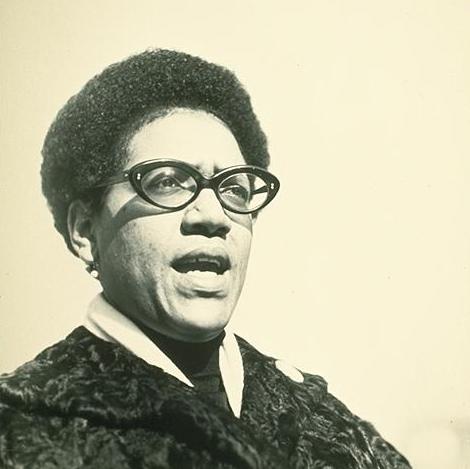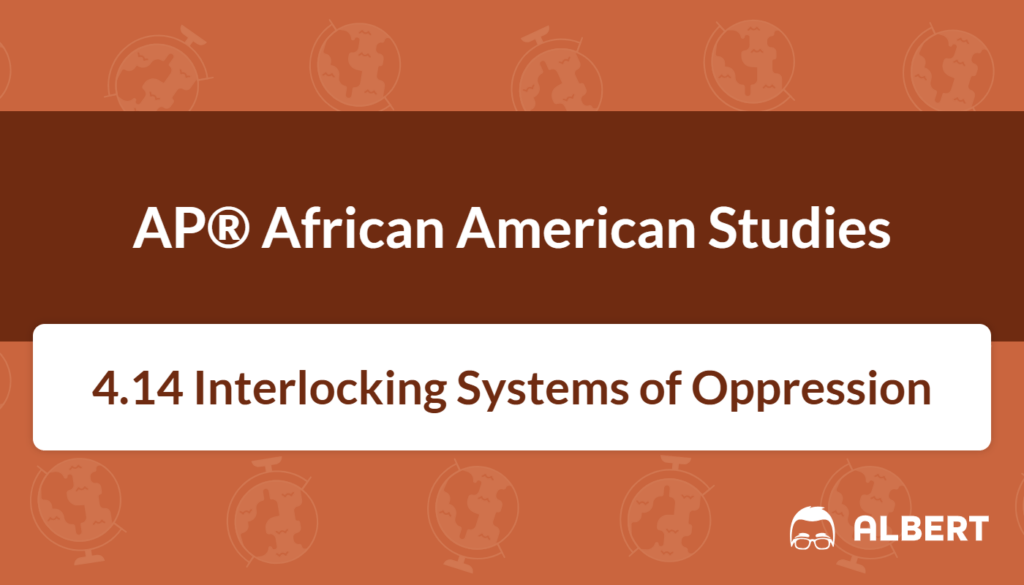What We Review
Understanding Interlocking Systems of Oppression: A Study Guide for AP® African American Studies Students
Introduction
Interlocking systems of oppression help explain what is intersectionality and how various social categories overlap and shape people’s lives. These categories include race, gender, class, sexuality, and ability. It is important to understand how they work together to create both disadvantages and privileges. Studying this concept helps students see why certain groups face more challenges and why these challenges are not solely based on one aspect of identity, such as race or gender.
By grasping the idea of intersectionality, students can better recognize how each person’s experiences arise from several parts of their identity. This approach has origins in Black feminist activism, where leaders like Patricia Hill Collins highlighted how different forms of oppression connect. Examining these issues allows classes in subjects such as AP® African American Studies to dive deeper into problems of inequality and envision possible solutions.
What is Intersectionality?
Intersectionality is a term describing how social categories, like race and gender, are interconnected. Rather than treating each category as separate, intersectionality shows how these categories overlap to create unique life experiences. For instance, a person who is both Black and a woman can face discrimination because of racism and sexism at the same time. This can influence how that individual is perceived or treated in various social contexts, including schools, workplaces, and community settings.
Understanding intersectionality is key for social justice work. Activists and scholars use the concept to examine how broader society often promotes inequality. Therefore, recognizing multiple identities is important for crafting effective policies that address everyone’s needs. These inclusive policies could support marginalized communities who face multiple challenges. In essence, intersectionality encourages society to view people as whole individuals rather than isolated groups defined by only one characteristic.
The Concept of Interlocking Systems of Oppression
Interlocking systems of oppression build on the idea of intersectionality by including the different social systems that maintain these inequalities. These systems include institutions like education, health care, housing, and incarceration. Each institution can treat people differently based on factors like race, class, and gender. When these factors overlap, they can produce more intense forms of discrimination.
Consider a hypothetical scenario involving a Black woman from a low-income area. She may face racial bias, sexism, and financial disadvantages all at once. For example, she might attend schools that receive less funding or have limited resources, while encountering hiring discrimination that stems from negative stereotypes about both race and gender. These issues do not happen in isolation; rather, they connect to each other in ways that make daily life more complicated. By seeing how these social categories work together to shape experiences, students can recognize that people’s struggles often emerge from multiple forces rather than from a single influence.
Historical Context: Black Feminist Activism
The idea of interlocking systems of oppression did not happen overnight. Earlier Black feminist scholars and activists paved the way for these discussions. They noticed that many social movements treated race, gender, and class as though they were unrelated. Patricia Hill Collins, a notable Black feminist scholar, built on their efforts by describing how these categories often work together to fuel injustice.
Other Black feminist leaders also influenced this field through writing and activism. Their work questioned why discussions about racism often ignored sexism, and why conversations on women’s rights sometimes overlooked issues like class or race. These figures recognized the complexity of real-life experiences and pushed for recognition of the many forms of discrimination that people may face. Their contributions helped shape modern social justice movements by urging individuals to see identity as a multilayered experience, rather than one shaped by a single category.
A Historical Case Study
Before modern conversations about intersectionality, many Black women in the 19th and early 20th centuries challenged oppressive structures in their communities. They formed clubs, advocated for voting rights, and protested unfair conditions in jobs and schools. While these groups often worked alongside broader movements, their perspective recognized the unique struggles at the crossroads of racism and sexism. Their actions set the stage for contemporary discussions about interlocking systems of oppression, emphasizing the importance of not separating race, gender, and class concerns.
Representation in Literature

Literature often provides a mirror for society, showing how interlocking systems of oppression affect everyday life. Authors such as Gwendolyn Brooks and Audre Lorde use poetry and prose to depict characters facing racial bias, sexism, and class-based challenges. These writers explore how people’s overlapping identities influence their lives, their roles within communities, and their chances for prosperity.
In the novel Maud Martha, Gwendolyn Brooks describes how African Americans navigate multiple layers of identity. The story centers on personal experiences, revealing how characters deal with race and class distinctions within and beyond their neighborhoods. By highlighting characters who experience discrimination both inside and outside their communities, Brooks shows that oppression does not come from only one source. Audre Lorde’s work, much like Brooks’s, underscores how different aspects of identity can combine to shape perspectives on power and self-worth.
Example: A Selected Passage
In Gwendolyn Brooks’s story “We’re the Only Colored People Here,” from Maud Martha, a scene depicts the discomfort and isolation African Americans feel in a predominantly white setting. This tension underscores how race intersects with social expectations, creating unique challenges. Through this literature, students can see how authors portray overlapping forms of discrimination in a way that illuminates the human cost of these inequalities.
Understanding the Impact
Interlocking systems of oppression influence many areas of society. These effects are not random but are sustained by institutions and policies that favor certain groups over others. Below are key social systems where interlocking oppressions are often visible:
- Education: Schools in predominantly Black or low-income neighborhoods often receive less funding. This disparity affects resources, class sizes, and extracurricular opportunities. Therefore, systemic bias in education disproportionately impacts students who belong to multiple marginalized categories.
- Health: Access to quality health care can depend on race, class, and geographical location. People facing multiple forms of bias may struggle to afford or find culturally responsive medical services. Therefore, health disparities increase and lead to higher risks for preventable illnesses.
- Housing: Discriminatory lending practices and housing laws have historically kept many Black families in segregated neighborhoods. This can overlap with economic struggles, especially when class status is also a factor. Consequently, limited housing options create crowded or unsafe living conditions.
- Incarceration: Institutional racism intersects with poverty and other forms of discrimination, leading to higher arrest and incarceration rates for Black individuals. Moreover, harsher sentences are often connected to systemic bias in law enforcement, courtroom practices, and legal policies.
- Wealth Gaps: Because of historical and current discrimination, wealth gaps between Black families and white families remain significant. Class status, combined with racial bias, amplifies the effect of interlocking oppressions in finance, job opportunities, and generational wealth.
Sources
- Brooks, Gwendolyn. “We’re the Only Colored People Here,” from Maud Martha (1953). This excerpt illustrates how a Black family navigates a predominantly white environment and sheds light on the complex interplay of race and class.
These sources connect directly to Learning Objective (LO) 4.14.A for the AP® African American Studies course, highlighting how scholars and writers address the overlap of social categories in maintaining or challenging systems of inequality. By connecting “We’re the Only Colored People Here” to the concept of interlocking systems of oppression, students witness how Black writers represent these realities in literature, linking to Learning Objective 4.14.B.
Quick Reference Chart
| Term | Definition |
| Intersectionality | The study of how different social categories overlap and affect individuals. |
| Interlocking Systems of Oppression | The interconnected nature of social categories that leads to complex social inequalities. |
| Black Feminism | A movement that addresses the unique struggles of Black women in a patriarchal society. |
| Social Categories | Categories such as race, gender, class, sexuality, and ability that shape experiences. |
| Activism | Efforts to bring about social change, often involving advocacy for marginalized groups. |
Conclusion
Recognizing interlocking systems of oppression is essential for understanding how multiple factors can impact a person’s experiences. Race, gender, class, sexuality, and ability do not function in isolation. Instead, these aspects overlap in ways that intensify oppression for certain communities. Scholars like Patricia Hill Collins have built on a rich tradition of Black feminist activism, showing that individuals cannot fully address racism if they ignore sexism, classism, and other social forces.
Literature by writers such as Gwendolyn Brooks and Audre Lorde offers rich perspectives on how these forces shape personal stories. By reading about characters’ struggles, students gain insight into how interlocking systems can influence real-life issues like education and housing. Developing a deeper understanding of these concepts encourages empathy and drives further inquiries into social justice solutions in both historical and modern contexts.
Sharpen Your Skills for AP® African American Studies
Are you preparing for the AP® African American Studies test? We’ve got you covered! Try our review articles designed to help you confidently tackle real-world AP® African American Studies problems. You’ll find everything you need to succeed, from quick tips to detailed strategies. Start exploring now!
Need help preparing for your AP® African American Studies exam?
Albert has hundreds of AP® African American Studies practice questions, free response, and full-length practice tests to try out.









